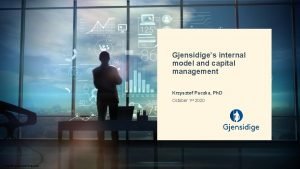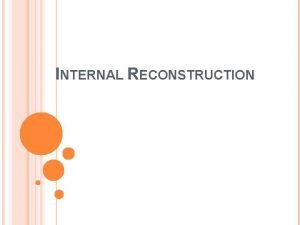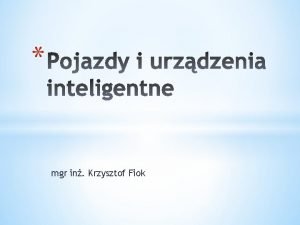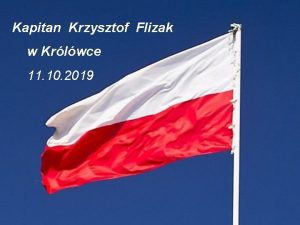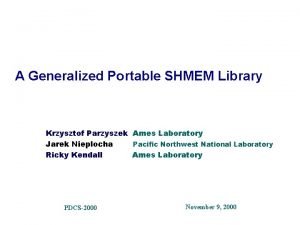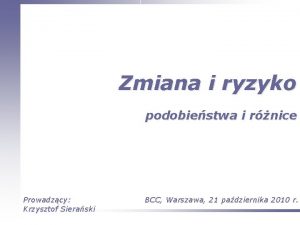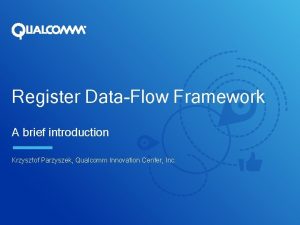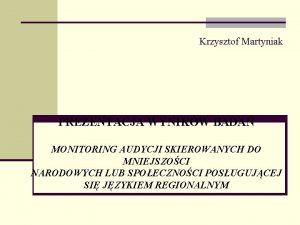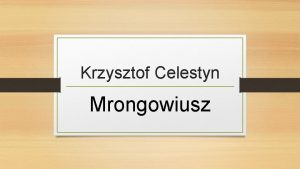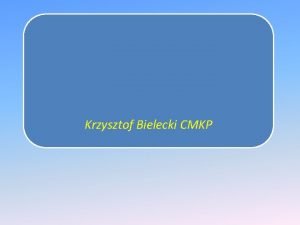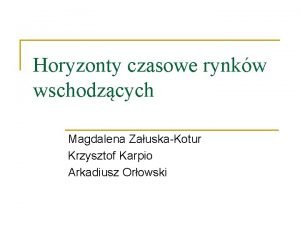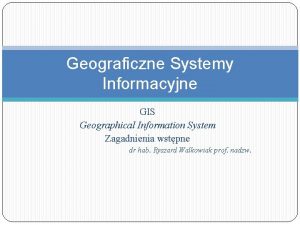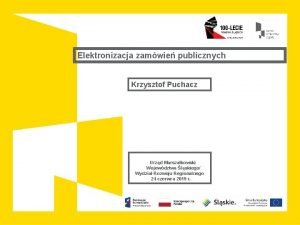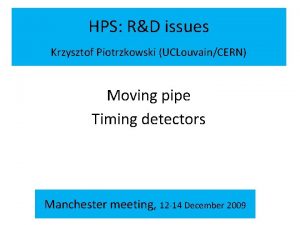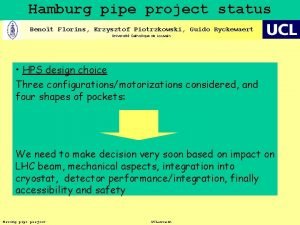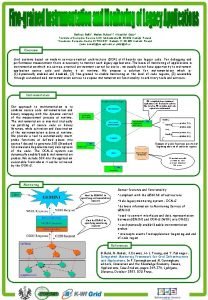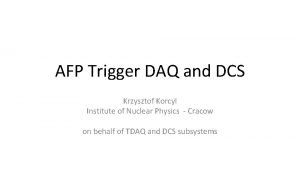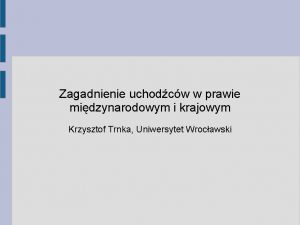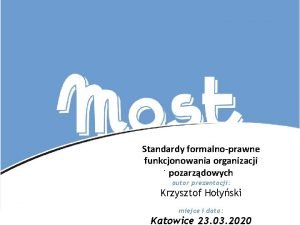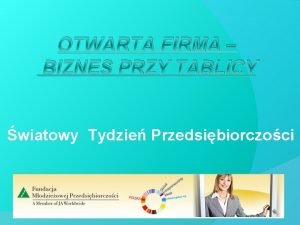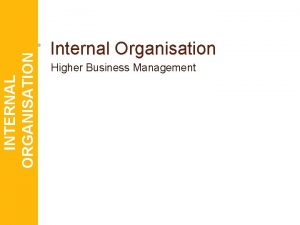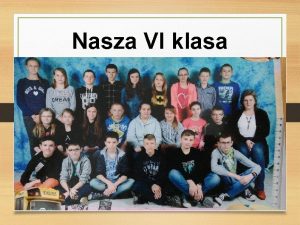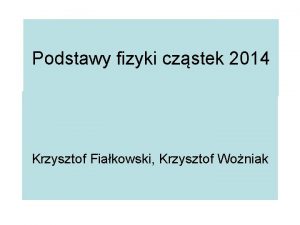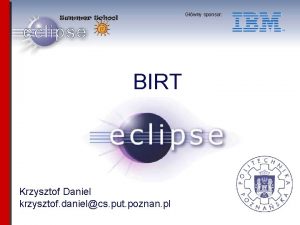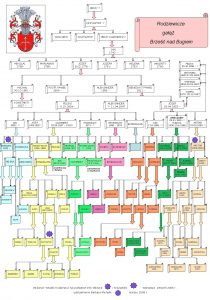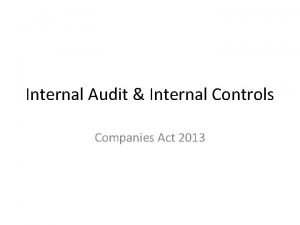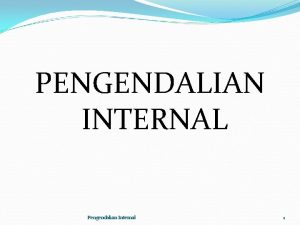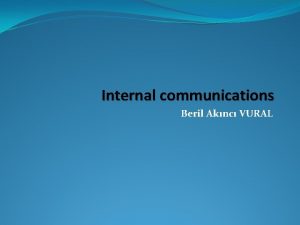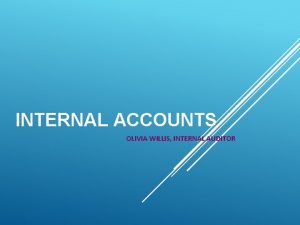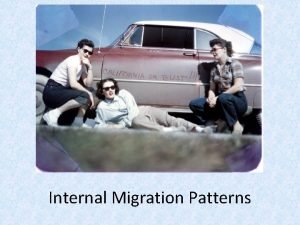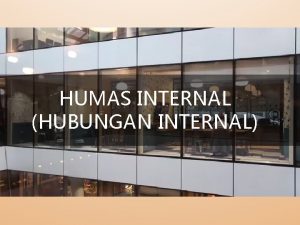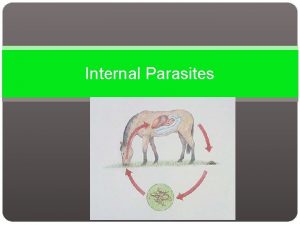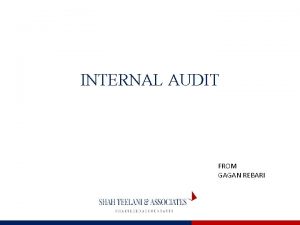Gjensidiges internal model and capital management Krzysztof Paczka






























- Slides: 30

Gjensidige’s internal model and capital management Krzysztof Paczka, Ph. D October 1 st 2020 Classified: General Business

Gjensidige’s internal model and capital management Agenda • About Gjensidige • Capital requirements and capital management • Models and tools used for capital managements • Multi-year model • Final words Classified: General Business

About Gjensidige Classified: General Business

Delivering superior customer experiences and stable returns Superior Norwegian position, strong potential outside Norway Growth ambition in Nordic/ Baltic region Ambition to secure strong position in Norway Sources: Finance Norway, non-life insurance, 1 st quarter 2020 , Insurance Sweden, 1 st quarter 2020, The Danish Insurance Association 2 tnd quarter 2019. Baltics Insurance Supervisory Authorities of Latvia and Lithuania, Estonia Statistics, competitor reports, and manual calculations, 1 st quarter 2020 1) Based on Net earned premiums for Gjensidige Q 2 2020 in each country Source: Finance Norway. 21 companies in “Other” category 2019 Classified: General Business 4

Stock dividend Unique model for customer dividend 3. 0 Gjensidige Billions kroner Customer dividend Gjensidige stiftelsen 20. 0 % Percentage of premiums Customer dividend paid out Customer dividend 15. 0 % 2. 0 • • 10. 0 % • 1. 0 5. 0 % - 13 percent of premiums in average Scheme for profit sharing with our customers Probably one of the very few companies worldwide who shares majority of its dividend with its customers. 0. 0 % 2010 2011 2012 2013 2014 2015 2016 2017 2018 2019 5 Classified: General Business

Capital requirements and capital management Classified: General Business

Crash course into capital requirements • Solvency Capital Requirement (SCR) = unexpected loss of own funds due to “ 1 -in-200 year event”. • Calculated either using a “standard formula” or with a partial/full internal model • Solvency ratio = ratio of SCR and Own Fund eligible to cover SCR Balance sheet before 1 -in-200 year loss Balance sheet after 1 -in-200 year loss Solvency Capital Requirement Own funds Assets Classified: General Business Technical provisions and other liabilities Own funds Assets Technical provisions and other liabilities Own funds before loss

Structure of standard formula 8 Classified: General Business

Gjensidige’s partial internal model • Approved by Norwegian FSA in January 2018 • First internal model approved in Norway • Scope: • Most of market risks • Most of non-life and health risks • Sophisticated simulation-based model using modern actuarial and financial models • Capital Requirement calculated based on Va. R • Many use areas apart from regulatory capital requirements. 9 Classified: General Business

Capital management in Gjensidige Main questions? Our tasks • What are risks that we face now and in the future? How those risk can influence our capitalisation? • Responsible for the Gjensidige group’s capitalisation • What is our capital requirement? How much capital exceeding the capital requirement should we hold? • Solvency targets and capital structure • Risk modelling, run and development of Gjensidige’s internal model • How large dividend can we pay out? • ORSA • How to use our capital to achieve our strategic targets? • SFCR and RSR • How to protect our capital from large underwriting or financial losses? • Support business decisions such as reinsurance strategy and investment strategy 10 Classified: General Business

Interactions with other strategic areas Dividend strategy Capital management 1. What dividend to pay out? 2. How much capital to support dividend strategy? Investment strategy 1. SCR for investment risk 2. Optimal level of investment risk 3. Target zone for solvency given investment strategy UW strategy 1. Minimal profitability targets to cover cost of capital 2. Future profitability and growth <> future capitalisation Reinsurance strategy 1. Economic Value Added of reinsurance programmes • Note that other strategic areas are also interlinked with each other. 11 Classified: General Business

Capital Management vs. financial targets and risk appetite Annual financial targets 2019 -2022 Role of capital management 1. Contribute to achieving financial targets through capital allocation given our risk appetite 2. Influencing future targets and risks appetite Shape targets and risk appetite Contribute to achieving targets Investigate relations between targets Classified: General Business

Capital modelling Classified: General Business

Internal model as a central capital management tool • Simulates profit/losses due to market and underwriting risk over 1 year horizon. • Granular modelling of different asset classes and lines of business, taking into account various risk factors and interrelations between them. • Does not include any future management actions. • Main use areas: • Capital requirement calculation • Analysing risk profile • Allocating capital to product segments and asset classes, calculation of RORAC for efficient capital allocation • Calculation of economic value added (EVA) for different reinsurance programmes • Calculation of minimal profitability targets used for pricing as well as development of new products • Many ad hoc analyses supporting other business functions Classified: General Business

Why internal model? Advantages Disadvantages insight Gives much more ough thr s es sin bu r into ou use of the model r view on Better reflects ou re risk and give mo appropriate SCR lling of Appropriate mode al non-proportion reinsurance better Granular model, on, ati ific ers div ts reflec ta uses our own da subject to Final calibration nts me ss se as FSA ts Heavy requiremen tion nta me cu do ing ard reg Leads to heavy cesses bureaucratical pro 15 Classified: General Business

ORSA capital projection model • Projects our capital and solvency position during the planning period (5 years ahead). • Deterministic model which: 1. takes Management Forecast (expected development on UW and investment, together with dividend, taxes etc. ) as an input 2. adjusts the results for solvency purposes (intangibles, discounting, premium provision calculation, expected profit etc. ) to get projection of Own Funds 3. calculates capital requirement based on the development from Management Forecast by scaling the distributions from the internal model as well as out-of-scope calculations. • This “base case” is supplemented with a few alternative scenarios, which take into account different assumptions on key variables than in the Management Forecast. • Allows for future management actions regarding the dividend. 16 Classified: General Business

Comparison of models Newest addition: multi-year stochastic model • Re-uses the simulations generated by the internal model to give a realistic simulation of future solvency balance sheet, results, dividends and capital requirements over 5 year period. • Can start simulation with a current balance sheet, or calculate start point based on some desired target • UW-side aligned to Management Forecast (in mean) • Flexible modelling of dividend, investment as well as capital strategies. • Explicit modelling of future management actions via dividend strategy and possible de-risking of the investment portfolio. • Implicit modelling of premium rate adjustments via autocorrelations on the UW-side. • Allows to analyse the interplay between different capitalisation, investment strategy 17 Classified: General Business

Multi-year model Classified: General Business

Top-down approach to modelling and rebalancing Simple model • We started with a very simple model: • Only one investment portfolio, no division between prior AYs and latest AY, very simple dividend rules etc. • Internal discussions: • Result: more complicated and realistic model, but still trackable Possible addition of new features Discuss results with a business function Feedback and expectation about effects included Classified: General Business • Development when applying the model with different business functions: • Additional functionality, including future management actions. E. g. de-risking portfolio after a large investment loss • May require changes in other parts of the model: e. g. change in capital requirement module after introduction of de-risking

How does it work? Other assets Own funds Free portfolio Match portfolio Other liabilities Technical provisions • We start with some initial balance sheet Classified: General Business

How does it work? Other assets Own funds Free portfolio Match portfolio Simulated returns Investment result Other liabilities Technical provisions Simulated runoff Runoff result • We apply simulated returns and simulated runoff result Classified: General Business

How does it work? Other assets Own funds Free portfolio Match portfolio Simulated returns Investment result Other liabilities Technical provisions Management forecast (UW) Simulated deviation from MF Simulated premiums, claims and expenses Simulated runoff Runoff result Reserves, latest AY Payme nt pattern Cashflows within a year UW result, latest AY • We calculate UW-result on the latest Accident Year, together with reserves and cashflows Classified: General Business

How does it work? Other assets Own funds Free portfolio Match portfolio Simulated returns Investment result Other liabilities Simulated deviation from MF Technical provisions Simulated premiums, claims and expenses Simulated runoff Runoff result UW result, latest AY Pn. L after tax Classified: General Business • We calculate result after tax Management forecast (UW) Reserves, latest AY Payme nt pattern Cashflows within a year Tax

How does it work? Other assets Own funds Free portfolio Match portfolio Simulated returns Investment result Other liabilities Management forecast (UW) Simulated deviation from MF Technical provisions Simulated premiums, claims and expenses Simulated runoff Runoff result • We calculate dividend, build a new balance sheet and rebalance the investment side based on chosen investment strategy. UW result, latest AY Reserves, latest AY Payme nt pattern Rebalancing of the investment portfolio Cashflows within a year Tax Other assets Own funds Free portfolio Other liabilities Match portfolio Technical provisions Dividend, SCR after dividend • We repeat the procedure with the desired number of simulation periods Pn. L after tax Classified: General Business

Our experiences with modelling 1. Capital requirement modelling most tricky: • SCR calculated in internal model as Va. R out of tens of thousands of simulations • Tens of thousands paths in multi-year model => exact SCR calculation would require to apply distributions from IM to each of the paths • Possibility of simplified approaches, e. g. through allocation and scaling of capital requirement. Not suitable if simulated balance sheets very different from each other. 2. Need for sufficient flexibility in coding: • Many changes in the model, improvements and new features • Take that into account from the beginning when dividing the code into modules, objects and functions 3. Realism of future management actions: • Some future management actions can depend on third parties (e. g. Norwegian FSA can stop the dividend, rebalancing/sale of the illiquid assets) • Inclusion of all possible future management actions not feasible (less trackable model). Better to check the sensitivity 4. Model is rerun under many different sets of assumptions. Keep run time short. Classified: General Business

Multi-year model and capital management • Allows to analyse interdependencies between metrics used as financial targets and other relevant metrics ROE Sustainable solvency ratio Dividend paid out • Give insight how to shape dividend, investment and capital strategy • “Optimization” problem Maximize ROE under constraints: Dividend strategy Investment strategy 1. 2. 3. 4. High and stable paid out dividend Sustainable solvency ratio Probability of breaking lower bound of comfort zone within risk appetite Probability of breaking lower bound of customer dividend within risk appetite Capital strategy 26 Classified: General Business

Limitations of the model and possible model development • Yearly simulation step, not really possible to prevent investment loss via de-risking. • Gjensidige Pensjonsforsikring included deterministically. Would be desirable to model at least the effect of changes in discount rate on technical provisions for life insurance. • Balance sheet only based on solvency valuation principles. Desirable to have accounting balance sheet, too. • Very high level modelling of the underwriting side. However, this is deemed sufficient for the purpose of the model. • Rather long run time (ca. 10 -20 min) despite parallel computing. • Implementation of other future management actions mentioned in the capital contingency plan. Classified: General Business

Final words Classified: General Business

Capital management is an exciting field • Many non-trivial problems and models to solve/analyse them • Direct influence on strategic decisions of Gjensidige as well as the customer divided received by our customers • Collaboration with different business functions as well as outside stakeholders (Norwegian FSA) • Deliverables discussed by C-suite and the board. Classified: General Business

Thanks for attention Krzysztof Paczka Analyst, Capital Management krzysztof. paczka@gjensidige. no Classified: General Business
 Krzysztof paczka
Krzysztof paczka Working capital management introduction
Working capital management introduction Difference between capital reserve and reserve capital
Difference between capital reserve and reserve capital Multinational capital structure
Multinational capital structure Difference between capital reserve and reserve capital
Difference between capital reserve and reserve capital Constant and variable capital
Constant and variable capital Multinational cost of capital and capital structure
Multinational cost of capital and capital structure Share capital reduction accounting entries
Share capital reduction accounting entries Krzysztof fiok
Krzysztof fiok Krzysztof flizak
Krzysztof flizak Krzysztof parzyszek
Krzysztof parzyszek Krzysztof sierański
Krzysztof sierański Krzysztof parzyszek
Krzysztof parzyszek Krzysztof zajda
Krzysztof zajda Chciał zostać poetą a wynalazł dynamit
Chciał zostać poetą a wynalazł dynamit Krzysztof martyniak
Krzysztof martyniak Krzysztof celestyn mrongowiusz
Krzysztof celestyn mrongowiusz Krzysztof bielecki chirurg
Krzysztof bielecki chirurg Nedela handlowa
Nedela handlowa Krzysztof juszczyszyn
Krzysztof juszczyszyn Krzysztof puchacz
Krzysztof puchacz Krzysztof dobosz umk
Krzysztof dobosz umk Krzysztof piotrzkowski
Krzysztof piotrzkowski Krzysztof piotrzkowski
Krzysztof piotrzkowski Krzysztof piotrzkowski
Krzysztof piotrzkowski Krzysztof bubak
Krzysztof bubak Krzysztof korcyl
Krzysztof korcyl Aronova palica
Aronova palica Krzysztof trnka
Krzysztof trnka Krzysztof hołyński
Krzysztof hołyński Krzysztof rdest stowarzyszenie
Krzysztof rdest stowarzyszenie
